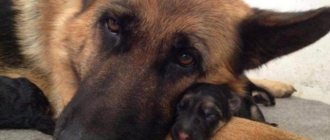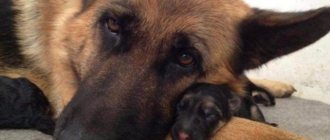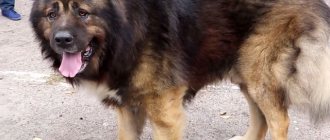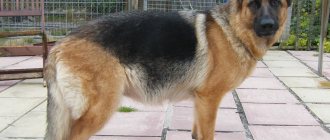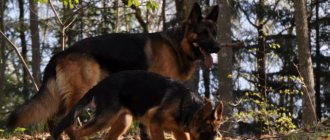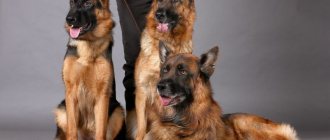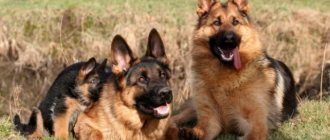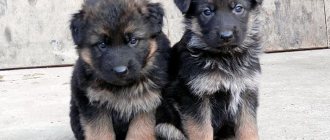Caring for a pregnant Caucasian Shepherd
Since the formation of the fetus begins from the very first days of the bitch’s pregnancy, during this period it is necessary to walk her properly, not limited to fifteen-minute trips outside, and feed her fully, preferably with food intended for pregnant dogs. Veterinarians recommend giving your dog easily digestible food that contains a lot of protein, adding fish oil, bone meal and fresh vegetables to the food. In the first half of pregnancy, the dog can be fed three times a day, and in the second half it needs to eat at least four times a day; the bitch must receive mineral supplements and vitamins.
After the first month of pregnancy, the dog should not jump or engage in exhausting running, and it is also recommended not to expose the pregnant bitch to stressful situations. The bitch must be excluded from training and work during pregnancy and lactation.
During the third week of pregnancy, the Caucasian Shepherd becomes “picky” about food and shows a lack of appetite even after a long walk. The dog’s behavior does not change; the only thing that some owners note is that their pets sleep more during pregnancy.
Varieties
In different areas the breed developed separately. As a result, several of its varieties were formed. Below is a description of the different types of Caucasian Shepherd breed.
- Georgian. Massive, tall representatives of the breed. The body is slightly elongated, elongated. The color is dominated by a monochromatic gray color scheme, long-haired.
- Armenian. Long-haired dogs with a single color. Less massive and tall.
- Azerbaijani. There are mountain and steppe. The mountain ones resemble the Georgian type. Steppe - short-haired, dark fawn or red in color, with elongated legs and a more square body.
- Dagestan. The largest type with a square body. There are long-haired, short-haired, different colors.
The first signs of giving birth to a Caucasian Shepherd
For each dog, the first signs of labor are individual, but in one thing Caucasian bitches who begin to give birth are similar to each other - their behavior changes greatly. They whine pitifully, scratch the litter and refuse to eat. Girls who give birth for the first time behave restlessly, do not find a place for themselves, and constantly run around the room. At these moments, the owner is required to have a gentle and attentive attitude towards his dog, and experienced owners of dogs of this breed recommend taking the pet to the veterinarian for examination a few days before giving birth, especially if this is her first birth. It will not be difficult for the owner to determine the proximity of the birth process, since five days before giving birth, the Caucasian Shepherd Dog will begin to secrete milk from the mammary glands, although during the first birth the bitch may not produce milk. When there is very little time left before giving birth, bitches, as a rule, lie down in a certain position - with their heads down between their outstretched front paws. The dog's noose becomes soft and a thick sticky discharge appears.
It is important for the owner to be fully prepared for the birth of his dog and to prepare in advance things that may be needed during childbirth:
- you need to prepare several bedding for a shift;
- need hot water;
- gauze napkins;
- scissors;
- sterilized linen threads.
It is necessary to prepare a dimly lit, secluded place for the dog, where there are no drafts. Many owners prepare in advance a durable box made of strong material with a removable insulated bottom.
Before giving birth, the Caucasian Shepherd dog needs to have the hair around the genitals and nipples trimmed.
Postpartum part
If your dog begins to breathe normally and finally calms down, then labor is over. You need to walk the dog while one of your relatives cleans the maternity ward. After a walk, wash your shepherd with warm water.
Illnesses after childbirth
On average, German Shepherds give birth to about seven puppies, but their number can easily reach fourteen. It happens that a dog eats its puppies. Why is this happening? When a dog gives birth for the first time, she may experience postpartum shock that lasts several hours. Carefully monitor the behavior of the shepherd in order to help the puppies in time. You will also have to stay with the babies for several days so that the shepherd does not eat them. If the dog does not eat the puppies within the first 24 hours, then this will almost certainly not happen. But it doesn't hurt to be on the safe side.
If your pet behaves too nervously after giving birth, moves away from the puppies, breathes frequently, has convulsions, and profuse salivation, then your German Shepherd has postpartum titania. These symptoms may continue for 24 hours. If the dog does not eat anything and does not want to relieve itself, it is necessary to wrap it up warmly and urgently call a veterinarian for medical assistance.
Why is it necessary to feed a shepherd dog food rich in minerals and vitamins and remove raw meat from the diet before giving birth? This is done to prevent titanium and postpartum depression. Sun exposure and calcium also help a lot.
Did our article help you? Tell us how your shepherd's birth went?
The birth process
Childbirth in Caucasian Shepherds usually proceeds calmly, without any complications, and the birth process can last for one day. Childbirth takes place in three stages. During the first stage, the birth canal expands. During the second stage, contractions become noticeable and the puppies are born, a process that can take about two hours. The placenta is delivered during the third stage, a process that occurs five to fifteen minutes after the birth of the first puppy. During childbirth, Caucasian Shepherds prefer to lie on their right side.
If labor is prolonged, that is, it lasts more than ten hours, then it is necessary to periodically take the dog for a walk so that it can relieve its natural needs, and physical activity will stimulate labor.
Dogs themselves bite the umbilical cord and eat the membranes of a newborn puppy, but the bitch should not be allowed to eat all the afterbirth, as this will lead to indigestion.
Interesting Facts
- The world's largest Caucasian Shepherd lives in Ukraine, in the city of Odessa. The pet's name is Grizzly, he weighs more than 100 kg;
- In 1933 I.V. Stalin signed a decree “On the development of domestic dog breeding”, as a result of which most of the Shepherd dog population was taken out of the Caucasus. In 1941, dogs were evacuated en masse after the start of the Great Patriotic War;
- Caucasian Shepherd Dogs were used to breed the Moscow Watchdog - mainly individuals taken from Azerbaijan were used;
- In the 30s of the twentieth century, a male named Topush, who killed more than a hundred wolves in his life, was recognized as the best working Shepherd Dog.
Caring for a whelping Caucasian Shepherd
After giving birth, a dog should not be exposed to physical activity; if the weather is cold outside, it is advisable to reduce walks so as not to expose the pet to possible diseases.
The mammary glands of a woman in labor and her genitals should be treated with a weak solution of potassium permanganate twice a day.
It is advisable that the dog be under the supervision of a veterinarian, but if circumstances do not allow for constant medical monitoring, then the dog must be taken to a veterinary clinic for examination at least several times.
Pregnancy in dogs: timing, periods and features of gestation of puppies in different breeds
Breeding a breed is a responsible and painstaking task that involves you in all aspects of the life of a particular animal. To get good results, breeders need to know how long pregnancy lasts in dogs, how it progresses, and what care the bitch needs. The expectant mother will need the help and support of the owner at every stage of pregnancy. Left unattended, it may not be able to withstand the load and suffer from complications.
How long does gestation last?
On average, the duration of pregnancy in dogs is 55-66 days, that is, about 2 months. The gestation period can shift downward (up to 53 days) or up (up to 71 days) without harm to the puppies if certain factors are present.
What affects timing?
Experienced breeders always note the mating date. It is from this day that they calculate how long pregnancy lasts in dogs. The following factors influence possible deviations from average indicators:
Number of births
. If a pet is pregnant for the first time, then her babies will not be in a hurry to be born. For more experienced animals, the process takes much less time.
Size and number of offspring
. The smaller the puppies, the longer they develop in the womb. An earlier exit can only be affected by their number. A small number of babies develop faster.
Size and age of the pet
. The smaller the animal, the faster the process proceeds. With age, the body weakens, so the dog bears its offspring longer.
Number of successful matings
. The female can become pregnant after the first mating, but if there is a repeat mating, start counting from there.
In the absence of pathologies, a shift in the estimated date of birth is possible due to later fertilization. This is due to incorrect determination of ovulation. In this case, the sperm will have to wait for the eggs to mature.
Period table
Having figured out how long the duration of pregnancy in dogs is, we can consider its main periods separately. For convenience, they are divided into weeks; the table describes the stages of fetal development and the changes occurring in the expectant mother.
by day 15-16, the length of the embryos increases to 1 mm, and their internal organs begin to form;
on days 17-19, the length doubles, the central nervous system, skull and spine appear;
by the end of the 3rd week (20-21 days), the body length increases to 5 mm, the heart forms in the embryo, and its membrane is visible on ultrasound.
On ultrasound, not only the membrane is visible, but also the fetus, reaching 1 cm on days 22-24 after mating;
by day 25, embryos have visible organs of the head, paws and teeth;
on day 26, the length of the embryos is already 1.5 cm, so the doctor can feel them by palpating the peritoneum;
by the end of 4 weeks, all puppies are clearly visible on ultrasound, their size reaches 1.7 cm, and the bones are gradually filled with calcium.
30-31 days the size of the babies is 2 cm, and vibrissae appear on their faces;
by the end of the 5th week, the size of the fruit reaches 2.7 cm.
fruit growth becomes more and more active: at the beginning of the 6th week their length is only 3.5 cm, and by the end - already 6.5 cm;
primary sexual characteristics and fur appear;
the bone structure grows.
all offspring can be counted on an x-ray on days 51-54;
by the end of the week, the babies increase to 15 cm.
While caring for your pet, strictly monitor its weight. Sharp jumps are fraught with hormonal disruptions and joint problems.
Calculation of due date
It will not be possible to find out the exact date of birth of the puppies, but it is quite possible to calculate the approximate date. Add to the mating date the average duration of how long the dog stays pregnant. Then try to adjust the resulting figure up or down depending on factors affecting the timing.
Throughout the entire period, the owner must observe the condition of the pet, comparing it with the table. If deviations from the schedule occur, contact your veterinarian immediately to prevent the development of complications.
Disqualifying faults
Disqualifying defects are those defects due to which the dog is not allowed into the ring. Vices can ruin a show career forever. The main disqualifying deficiencies include:
- docked tail;
- severe aggression or cowardice;
- bite problems;
- difficulties in assessing the movements of an individual;
- color of the iris that does not meet the standard;
- shades of the nose, eyelids and lips are not black;
- the presence of an unregistered color (black and tan, black and white, blue, liver, etc.);
- The height of a male or female is below the minimum specified by the standard.
Signs of an interesting situation
It is quite difficult to guess that a pet is carrying puppies in the early stages. At first, only behavioral changes are noted that are noticeable to attentive owners. The expectant mother becomes inactive and refuses long walks. She gets nervous in noisy companies and tries to find a secluded place. Her appetite increases or decreases sharply, and she often vomits in the morning.
After detecting these symptoms, be sure to visit a veterinary clinic. More obvious signs appear only a month after fertilization. A pregnant woman's belly becomes rounded and enlarged. Viscous mucus is released from her loop, and the nipples swell.
By the end of 2 months, babies can be palpated, but this is recommended only under the supervision of a veterinarian. Fragile fruits are easy to injure, so avoid self-examination.
Differences in timing between dogs of different breeds
To determine the timing of thoroughbred animals, you need to start from their dimensions. The larger they are, the longer it takes to form fruits.
In small
Small breeds (Chihuahuas, Pekingese, Yorkies) carry their young for 55-60 days. Their offspring are always the most numerous.
Due to its modest dimensions, future mothers often encounter gastrointestinal problems. Their enlarged uterus begins to crowd the stomach, so food is made as high in calories as possible, but small in volume.
In the middle ones
Average breeds (boxers, huskies, spaniels) are less likely to suffer from complications, and the number of embryos is always determined by chance. The entire process takes 60-63 days.
In large
Large representatives (wolfhounds, mastiffs, mastiffs) remain pregnant for 63-65 days, but sometimes the period is extended to 72 days. This is due to the cubs being too large and requiring a long time to develop. Despite the small number of offspring, childbirth often occurs with complications due to the problematic passage of overgrown babies through the birth canal.
Origin story
The basis of the history of the Caucasian Shepherd dog breed is the natural formation of large and hardy animals. The natural habitat of the ancestors of modern dogs is the Caucasus and the steppes of southern latitudes of Russia. There are two versions of the origin. First, the ancestors of the breed were the Great Danes of the state of Urartu. The second is Tibetan baiting dogs.
The formation of appearance and character was influenced by the national traditions of the Caucasus. Dogs protected flocks of sheep from bears and wolves. This is where the unofficial name came from - wolfhound. The need to frequently engage in battles with dangerous opponents contributed to the acquisition of fighting skills.
Visit to the veterinarian
After detecting the listed signs, make an appointment with a veterinary clinic. Plan a visit no earlier than a month after mating. By this time, relaxin, a sex hormone, will appear in the blood of the expectant mother, on the basis of which an interesting position is confirmed.
Determining the number of fruits
In addition to examination, palpation and blood tests, diagnosis involves ultrasound and x-rays. These procedures help determine the exact number and condition of the fruits, but not earlier than the beginning of the 2nd month.
Exclusion of pathologies
A visit to the veterinary clinic is recommended even if your four-legged pet is in good health. Not all pathologies are determined visually. Diagnostic procedures help to detect hidden complications and prevent their development.
Caring for the expectant mother
During the period of bearing offspring, protect your pet from stress factors. Avoid meeting new people and staying in noisy places.
Remember that any cold will be more severe than usual. Do not let your pet sleep on a cold floor and make sure that her place is protected from drafts.
Particular attention will have to be paid to feeding and physical activity. Also, do not forget to prepare the “nest”, that is, the future place for childbirth.
Feeding
For full development, embryos will need vitamins A, B, D and E. They can be added directly to food, checking the brand with your veterinarian. To form bone structure, the diet is enriched with calcium. It will also be necessary to increase the amount of proteins that perform a construction function. You need to return to the previous amount of protein food 10 days before birth, and 5 days before giving it up completely.
In the first month, feedings are carried out 2 times a day, in the second - 3 times a day, and shortly before birth - 4-5 times a day. Try to keep carbohydrates to a minimum to prevent obesity. The easiest way to feed your animal is pregnancy food.
Walking and activity
Reduce the length of the route while maintaining the duration of the walk. A pregnant pet will become slower, so it will take more time for her to cover the usual distances. If you feel tired, listen to the animal and return home.
It is better to increase the number of walks up to 3 times. This will be needed to relieve the burden on the bladder, which is being compressed by the enlarged uterus. If this is not possible, stock up on diapers. A tray is suitable for small dogs.
Running, jumping and walking on stairs are prohibited. Try to carry your pet in your arms or use the elevator more often.
Hygiene
No innovations in hygiene procedures are required. Treat your eyes and ears as usual. Wash your paws after every walk. Entire bathing is best done only as a last resort. After washing, be sure to dry your pet with a towel and hairdryer to prevent hypothermia.
Preparing for childbirth
In the second half of the 4th week, prepare the birth area. If your pet does this on her own, she will definitely choose a secluded corner behind the sofa, where it will be difficult for her to provide help if necessary. Make sure that the design you choose is safe, retains heat well, and appeals to the expectant mother.
7 days before giving birth, contact your surgeon or prepare all the necessary instruments yourself. Try to arrange a vacation from work in advance to support your pet in the first days.
- Stud dog
- Breeding bitch
- Mating
- Puppies
- False pregnancy
- Preparing for childbirth
- Childbirth
- Newborn puppies and their care
Breeding work and obtaining offspring
The Caucasian Shepherd is one of the brightest, most attractive breeds of service dogs. Puppies are invariably in demand, so reproduction is in full swing. Dogs are bred, litters are produced, raised and sold. But in order for the breed to maintain and increase its superior qualities both in exterior and in working terms, breeding work with it must be carried out competently. That is, according to the zootechnical laws that have been developed by all the previous experience of mankind. Of course, even today, every now and then there are nuggets who begin to “reinvent the wheel” and breed dogs, guided by abstruse ideas. We know that scientific facts are stubborn things, and following the rules of breeding and genetics is more likely to lead to good results.
Your club's livestock specialist should be fluent in all the subtleties of breeding, but if you disagree with him on something, buy special books and educate yourself.
We will only help you a little by shedding light on the basics of breeding. Breeding is carried out according to genetics, which studies the laws of inheritance of various traits in your dog. It was found that most disqualifying defects (see standard) are inherited, therefore dogs with any of these defects cannot be bred, and it is generally criminal to breed with each other.
Breeding is based on two main methods - selection and selection. Selection, or actually selection (you've probably heard such a word) is the selection of the best individuals for breeding and the rejection of mediocre and vicious individuals. And selection is the subtle science of “who to match with whom.” The fact is that there are no dogs without flaws. And when planning to get puppies, we set the goal of getting descendants of better quality than their ancestors. That is, we are trying to preserve the merits and desired type of parents, and correct their shortcomings in their descendants as much as possible. So, for a bitch with soft pasterns, we must choose an excellent dog with strong hind legs, and for a bitch with short shins, an excellent dog with good hind legs. Under no circumstances should one defect be corrected by another, its opposite. Thus, the X-shaped position of the legs is not “corrected” by Conformity, but only by normal.
In general, selection is a creative process. And in addition to all zootechnical knowledge, the hand of the breeder is guided by the hand of providence. Therefore, the best breeders have a breeder's instinct and intuition.
Breeding is carried out according to the principle - the best with the best. Males strive to match a female dog so that he is an order of magnitude better than her, and not vice versa.
The selection for males is always more stringent than for females. Only those males who have outstanding characteristics and a rating of at least “excellent” are in demand. Many males who live in kennels and work as guards do not have the opportunity to show much, but, believe me, the leading breeders are aware of all the best dogs and have their own opinion about them. And yet, the main “shows” take place at large exhibitions specialized in this breed.
Many of the bitches who receive a rating of at least “very good” are accepted for breeding. But the most interesting and sought-after puppies come from the best females mated to the best males.
Stud dog
If you have a high-value stud dog and plan to use him for breeding, it is important that he is in excellent shape and health.
During the mating period, the male dog is increased in the amount of protein food due to meat and dairy products. Raw eggs are also included in the diet.
Some experienced dog breeders recommend “untying” a male dog for the first time at the age of 1.5 years. However, he can receive regular sexual activity only after he reaches 20 months of age.
A stud dog should be taken care of, and a full load (up to 20 bitches per year) can only be given to a completely adult dog - after 2.5-3 years.
The male must be in good physical shape and not be overfed.
Since mating often requires the help of an instructor, the male must be socialized and have good contact with the owner. The raising and education of a male dog with a breeding perspective is structured in such a way as not to disrupt the correct formation of sexual behavior. A promising puppy should communicate and play with peers, including females, and should not be prohibited from sitting while playing with other dogs.
Breeding bitch
It is well known that the basis of any breeding kennel is a good, high-breed bitch. If you are attracted by the prospect of breeding (and not just breeding for the market), be responsible in choosing the breeding stock, or, more simply, the breeding bitch. It would be a good idea to consult with leading cynologists on the Caucasian Shepherd breed, and also, again, visit a number of specialized exhibitions and form your own idea of the breed and what you need.
If your choice is successful, your pet will soon delight you with victories at exhibitions, you will have a lot of fans and envious ill-wishers, but most importantly, you will have potential clients for puppies.
If you decide to get offspring, it would be wiser for your bitch to already be known in wide circles of “Caucasian people”, and also for her to already be titled, have a title, for example, “Champion of Russia” (or another country), “Champion of the national breed club", "International champion".
A bitch, proving her highest quality, will most likely bring offspring to match herself. It is only important to choose a worthy male for her.
Bitches of the Caucasian Shepherd breed are allowed to be bred when they reach 18 months of age, provided they have a testing diploma, an exhibition rating (for bitches - at least “very good”) and training (see appendix “Admission to Breeding”).
You should prepare for mating, comply with all the formalities at the club, try to ensure that the bitch is in factory condition for mating, but in no case fat. Knowing the approximate period of estrus, do not miss the first days.
Mating
Mating takes place in the male dog's territory. You should prepare well for mating - get a referral from the club, get rid of worms before the start of estrus, and vaccinate the bitch. Only healthy dogs are bred. Usually a bitch is bred for 12-14 days, but, of course, this is a living creature and everything can go according to an individual scenario. Some bitches may be ready to breed on the 5th day, others - on the 16th, or even 20th day from the start of estrus. Readiness for mating is checked by the degree of the bitch's desire for mating. When you press your finger on the sharp corner of the loop, the bitch should lift the latter up and move its tail to the side. When the hunt is intense, the bitch even reacts to a hand placed on the croup - she arches her lower back, pulls her tail back and lifts the loop. In addition, a bitch in heat begins to take an active interest in males and can even run away from the yard by digging under it.
Also, the day of mating can be determined by the type of discharge from the loop.
At first they are profuse and bloody. When ovulation occurs (the release of eggs), they become lighter. 1-2 days after ovulation, the eggs mature and become ready for fertilization. In this case, the discharge becomes even lighter and acquires a yellowish tint, and its quantity decreases.
During this period, matings are the most favorable. By the way, many experienced males begin to “specifically” breed a bitch only when such complete readiness occurs, and before that they only groom, lick her loop and ears, but nothing more.
If you are mating your bitch for the first time, we recommend that you carry out this process under the guidance of an instructor experienced in such a difficult task.
Typically, owners breed their dogs in an apartment or house, for example, in the kitchen or hallway. It is important to place a rug under their feet, this will give the dogs stability. If there is a vacant lot near the house, mating can be done there, sitting on some logs or stones, which litter our parks and vacant lots in abundance.
It’s another matter if you brought your bitch to a departmental nursery to breed. Free mating is often practiced there, that is, the bitch is released into a fenced-in area with a male dog and they “negotiate” and mate without human help. Typically, this method is suitable for bitches who have interacted a lot with other dogs in their lives and understand their specific “language” well.
If your bitch grew up in isolated conditions, then it is better for you not to take risks and not to breed your bitch “freely”; it is better to carry out the mating under the guidance of an instructor.
Actually the knitting looks like this. The bitch is brought into the room, a muzzle, collar, and short leash are put on and the male is released. If the dog is angry, he is also given a muzzle and a collar with a leash. An experienced producer usually comes out to the bitch wearing only one collar. However, the owner (and his instructor) knows the capabilities of his dog better, and he is responsible for ensuring that the mating is successful and, most importantly, safe.
The male and female get to know each other, sniff each other's noses, ears, and genitals, and make attempts to flirt with each other. It is worse if one of them does not want to enter the most crucial stage of the process for some reason. Usually young, inexperienced or particularly obstinate bitches are guilty of this.
If such a bitch is ready by all indications, but is afraid of a dog or does not allow mating for reasons of her bad character, the matter can be helped.
The owner of the bitch sits on a strong chair and confidently holds her by the collar in a position with her head facing him.
The instructor or owner sits on a chair next to the bitch and places his knee under her belly so that she does not sit down at the critical moment and adjusts the bitch with his hands so that her loop is parallel and at the level of the male's penis. Sometimes bitches “clamp”, hide the noose between their legs and cover it with their tail. Rice.
11. Knitting The tail must be pulled to the side and secured with your hand, and the loop must be lifted and straightened with your fingers.
When helping dogs, they always work only with the bitch, but never touch the male with their hands. Touching a male dog's penis leads to various negative consequences - leaving the bitch or even directed aggression towards the instructor.
When the penis enters the vagina correctly, the male makes frictional movements, “dancing” with his hind legs. Then he freezes for a second and begins to turn around, moving both left (right) paws over the bitch and stands tail to tail with her. In this case, the dogs must be held by their collars and ensure that they stand calmly and do not harm each other. This temporary “bonding” of dogs with each other (that’s why the process is called “mating”) is determined by the anatomical structure of the canine reproductive system. Gluing (or, in simple terms, “lock”) is caused by the fact that the repeatedly enlarging cavernous bodies of the male’s penis are captured and held by the muscular ring of the female’s vagina. The mating lasts an average of 15 minutes (sometimes from 3 to 45 minutes) and stops on its own. In the “castle” the dogs should stand quite close to each other, not pull, lie down or sit down. To do this, they need to be supported.
Bitches come into heat once every 6-12 months, usually strictly periodically. A bitch's estrus characteristics are often inherited from her mother. You can breed a Caucasian Shepherd dog, as already mentioned, from 18 months. How often you will breed a bitch depends on her health and your intentions, but no more than 6 times during the entire breeding period (up to 8 years). The best scheme is mating once every 1 year (“through heat”).
Puppies
In all dogs, regardless of breed, pregnancy (pregnancy) lasts an average of 63 days (from 57 to 72 days). Usually counted from the day of the last mating, if there were several.
Very often, a “mated” bitch changes her behavior after the end of her heat. She becomes calmer, sleeps more, secludes herself, as if “withdrawing into herself.” But there are exceptions to this rule, like any other. Some bitches continue to have a very active lifestyle. And according to the instructions adopted in departmental nurseries, bitches up to the 5th week of pregnancy can be used in work (naturally, not related to overcoming obstacles and other sudden movements). The other extreme is a bitch that vigorously demonstrates pregnancy after mating, but then turns out to be “empty.” In the latter case, false puerility usually develops; we will talk about it separately.
It is possible to determine by external signs whether a bitch is pregnant no earlier than the 5th week. Then the bitch expands somewhat in the sides, the udder forms into two clearly palpable beds. The loop may also be looser than usual. Sometimes there is a clear mucous discharge from it.
The feeding and maintenance regime in the first month of pregnancy is standard. However, if it is especially cold outside or at normal times she received a minimal diet, the bitch should be transferred to more favorable conditions and feeding should be improved.
Particular care must be taken towards the bitch in the second half of pregnancy. She should be protected from various adverse influences, especially from fights with other bitches, falls and jumps. The diet is gradually increased by 30-45%, enriched with meat and dairy products. All dog food must be of high quality.
Particular care should be taken to ensure that the bitch and fruits do not experience a deficiency of the main mineral elements - calcium and phosphorus. Phosphorus in animal feed is usually sufficient. Calcium almost always has to be added specifically. For particularly punctual breeders, we note that the amount of calcium in the diet of a pregnant bitch should be at least 67 mg per 1 kg of body weight per day. In order for calcium to be absorbed correctly, it is produced in the form of special salts, often in a certain combination with phosphorus (in the proportion Ca: P as 1.5-1.2: 1) and vitamin D3. You should feed 3 times a day.
In the second half of pregnancy, the bitch is released from work, but physical activity in the form of sufficient exercise is necessary. At the same time, the dog should not get tired.
The Caucasian Shepherd is a large dog with powerful abdominal muscles. Therefore, palpating the fruits is a difficult task. In addition, the dog will most likely react to this with indignation. Therefore, if there is no urgent need, there is no need to show obsessive curiosity, wait until the day of birth.
In the best case, the bitch will whelp on time, in the worst case, there may be difficulties caused by pathology and requiring the intervention of a veterinarian, or the bitch may remain “empty” and in this case the worst option is false whelping.
False pregnancy
It occurs both in bitches that have been bred and in those that are not bred at all.
This phenomenon is expressed in the fact that after two months after the period of heat and ovulation, the bitch “builds” a nest, imitates childbirth, milk appears in her, she “accepts” toys and various objects as her puppies, warms them, “feeds” them, licks them and protects.
And this must be taken seriously. Don’t carelessly enter the lair of such a fake “mother,” and especially don’t try to take away her own slippers and other things that she “loves” as if she were her own children. The bitch may come at you in defense of them. It is better if you leave her alone for a while, and when the maternal fervor subsides on its own, begin to actively distract the bitch with walks, jogging and training, and also reduce the diet and amount of fluid to reduce milk production.
A serious problem that occurs with false pregnancy is mastitis (inflammation of the mammary glands). The udder may become rough and swollen, and in light-colored dogs there may be noticeable redness. The dog experiences pain, and the temperature often rises (above 39.1°C in dogs the temperature is considered elevated). Mastitis is treated with the assistance of a veterinarian.
In some bitches, false pregnancy does not appear at all, in others it is weakly expressed or only some of its elements are present. As a rule, busy bitches who are not particularly burdened with work are predisposed to this. And further. In bitches with a “false dog,” the puppies cannot be observed moving before “giving birth.”
Preparing for childbirth
The last, 8th and 9th weeks of pregnancy, have some specifics. The bitch noticeably increases in size, walks heavily, sighs heavily, and it is clear from everything that it is not easy for her. She often feels the need to recover, so bitches living in apartments are walked more often than usual. Long walks are carried out less frequently and at a leisurely pace.
10 days before giving birth, it is customary to exclude raw meat from the diet, replacing it with boiled meat. In the last week, reduce the amount of food by 20-25%.
All this time they monitor the condition of the bitch, without leaving her alone for a long time. The loop swells and increases. In the last days before giving birth, it is advisable to cut off the lush hair surrounding the loop and below it (recommendation only for bitches living in an apartment). Clear mucus sometimes comes out of the loop. The udder and nipples swell, and colostrum is released from them when pressed.
In general, the Caucasian Shepherd is a strong, healthy dog; it normally gives birth on its own, but in some cases it simply does not allow helpers to come to it.
Especially if she grew up in an enclosure in the yard and is used to taking care of herself. Most of these bitches are well developed physically and hardened; in addition, the instinct of procreation and care for offspring have been developed in the breed over centuries of harsh selection. Rice.
12. Schematic section of the maternity box Still, apartment dogs, which are more human-oriented and dependent on him, often need obstetric assistance. In addition, if this process is not organized correctly from the very beginning, a variety of problems can arise. For example, a bitch can whelp on (under) your bed, in the kitchen under the table, and besides, she will not let you into “her” room. To avoid this, build your bitch a maternity box (playpen) of sufficient size and height in advance and agree with your dog that she will give birth there.
At the time of giving birth, kennel bitches are taken to a room where the air temperature is at least +5°C.
There are many examples where bitches gave birth in winter in cold, unheated rooms and fed their puppies normally. But these are extremes and incompatible with cultural dog breeding.
Childbirth
The onset of labor, as already mentioned, occurs approximately on the 63rd day from the day of the last mating ± 9 days. But with free mating, it is often difficult to determine on what exact days the bitch was bred. Therefore, most often the approach of labor is judged by accompanying signs.
The most accurate way to determine the day of birth is by temperature fluctuations, which in dogs is normally 38.5-39.0°C. Within about 5 days it begins to fluctuate. A decrease to 37.2-37.5°C followed by an increase indicates that labor will begin in a day.
During birth, the temperature drops to 36.5°C, and then after the birth of the first puppy it begins to rise and the next day reaches 39.1-39.3°C.
You can establish a rhythm only by measuring your temperature regularly in the morning, lunch and evening and recording the data in a notebook (the temperature is measured by inserting a thermometer into the anus for 2 minutes).
Such a detailed determination of the moment of birth is completely justified if there is any veterinary need, and if the owner has a trusting relationship with the bitch.
It’s easier to know that labor is approaching by looking at the bitch’s behavior. She breathes quickly, from time to time she is shaken by slight tremors, the bitch walks, lies down and gets up, as if finding no place for herself, she digs. After some time, the contractions release her, she takes advantage of the moment, lies down to rest and even falls asleep for a while. The bitch refuses to eat and should be taken out into the yard often, as the bladder and rectum are under pressure.
Here you need to be on guard - the puppy can be born right at the moment of the bitch’s natural birth. Don't forget to take a diaper.
It is considered optimal when the bitch gives birth lying down. But in large breed bitches, childbirth often occurs in a sitting or standing position. In the latter case, the animal arches, as if defecating, strains and the amniotic sac with the puppy enclosed in it appears from the loop, or, if the sac is ruptured, the puppy can walk with its head (as they say, have a cephalic presentation) or with its hind legs (breech presentation).
The first puppies are usually born with a short interval in time, but as they decrease in size in the uterus, the process begins to drag on.
An overstretched, devastated uterus cannot provide such strong efforts. The bitch herself was tired and exhausted. Here you can support her by offering sweetened milk tea.
Birth of a puppy
- this is always a whole event, the bitch receives certain puppies - a gray boy, a fawn girl, etc. With bated breath, a person accepts a new life in his hands (unless, of course, he is against the bitch).
Puppies are born with or without membranes. The Caucasian Shepherd bitch usually bites through the umbilical cord without any problems and licks the puppy, stimulating it to life with her massage tongue. Often, something brown-green in color trails behind the puppy on the umbilical cord. This is the afterbirth. The bitch immediately eats it and the shells, licking the water spilled around.
If you suspect that the woman in labor has some health problems, make sure that there is no placenta left in her (the pathology is called retained placenta). There should be exactly the same number of puppies. If some of the placenta does not come out even after the end of the birth process, the bitch should be helped. Let your veterinarian give her a shot (injection) of a special drug, under the influence of which the uterus will actively contract and push out the “stuck” placenta. But do not administer anything yourself, since first you need to make sure that there are no puppies in the bitch, and you also need to correctly prescribe the medicine and calculate the dosage.
If your bitch for some reason only gives birth to puppies one after another, but does not process them, things are bad. If the bitch is young, you can try to tell her what to do, bring the peeled puppy under her muzzle, and let her sniff it. Often young mothers are hesitant at first, but begin to lick the puppy, gradually getting the taste. Otherwise, urgently open the bubble yourself, free the puppies and break the umbilical cord, leaving about 2 cm.
If the puppy, by all indications, was born “dead” and does not show signs of life, decide for yourself what to do with it. If he is smaller than the others, thin and long, and even with some kind of defect, it would be more correct to submit to fate and leave him as he is.
But if he is large and, by all appearances, a very thoroughbred, immediately try to resuscitate him. To do this, the puppy is actively rubbed with a towel, gently but decisively shaken upside down (with its hind legs), holding its head, and carefully (through a handkerchief) the mucus and liquid that it swallowed in the womb are sucked out of the respiratory tract. The last resort is to lower the puppy up to its neck into a bowl of hot water (55°C). If this doesn’t help, then, as they say, it’s not fate...
After treatment with the tongue (or a towel), a resuscitated or just born alive puppy should be placed under the udder of the bitch, and sometimes help find the nipple. And this again, if the bitch allows.
The first drops of colostrum are very useful for the puppy, with them he gains immunity.
There may be a break during the birth process - the bitch can lie down to rest and fall asleep. Don't bother her. She may also ask to go to the courtyard, then immediately take her out and, better yet, without waiting for the elevator, take the stairs. Movements stimulate labor well.
After giving birth, the bitch is left with the puppies in her crate and is not bothered. Often, after giving birth, having rested, the bitch becomes angry and does not even allow anyone close to her lair. There are bitches who have to give birth in a muzzle, otherwise they won’t let either the owner or the doctor near. This suggests that the owner for this bitch is not an authority.
However, the bitch must be taken outside. At first, it may weaken, and the stool will be black. Don't be alarmed, it's from the afterbirth that was eaten. After 2-3 days, the stool should return to normal. Offer the dog semi-liquid rice porridge, boiled meat, tea with milk. The first two days the dog may refuse to eat, and this is normal. Then she should have a voracious appetite. There must be water constantly.
If the bitch allows the owner to approach the “nest,” food and water can be placed so that the bitch can eat and drink without getting up.
In an enclosure or kennel, bitches that have given birth are usually quite aggressive, so you should not irritate them for the first three weeks. And it is also necessary to note one feature inherent in many working dog breeds. The bitch eats all stillborn puppies, as well as puppies that die or are accidentally killed on the day of birth, in order to keep the nest clean. This fact often shocks city residents and traumatizes the psyche of children. But this is an instinctive measure inherited by the dog from its ancestors. And there is nothing unnatural about this.
But if you are helping during childbirth, it is better to immediately take all stillborns away from the bitch and bury them.
Newborn puppies and their care
Speaking about the Caucasian Shepherd, first of all, one should distinguish between bitches with puppies kept in an apartment and those kept in an outdoor enclosure. The latter, as a rule, are very independent and often do not allow human intervention in the process of raising puppies. A person can only feed the dog well, clean the nest and inspect the puppies when the bitch is taken for a walk. At the same time, you should take good care of the reliability of the equipment (collar, leash, muzzle) and locks in the enclosure, so that the bitch, suddenly returning from a walk, does not take you by surprise.
In the enclosure for the bitch and puppies, it is necessary to maintain a positive temperature, ensure that she is always well-fed, and that there is plenty of drinking water in the enclosure. For a bitch with puppies, it is important that the place is not damp or in a draft.
For dogs that whelp in an apartment, more favorable living conditions are obviously created. However, the Caucasian Shepherd is not a pampered breed and usually does not need any special conditions or special heating.
Keeping a bitch with puppies in an apartment is only possible when she is well socially adapted and controlled by her owner. In the first days after whelping, it is better not to approach the bitch with children and family members who are not particularly authoritative for her, and especially with guests and strangers. At first, the bitch should be fed semi-liquid porridge; in case of diarrhea, it is useful to give slimy rice water.
The puppies continuously suckle the bitch. They line up in a row along the udder and suck, helping themselves to the rhythm of sucking with their front paws. If the bitch does not have enough milk, the puppies finger the nipples, squeak, and crawl around on the bedding.
This happens when the bitch is unwell, not fed enough, or has too large litters.
During the first few days, the bitch’s mammary glands secrete colostrum, which is very valuable for the puppy’s immunity, then milk begins to be produced. Its amount increases until about 21 days of lactation, then gradually decreases.
The bitch constantly takes care of the puppies and licks them. During the first days, the puppies cannot empty their bladders and bowels on their own; the bitch massages their bellies with her tongue. If the young dog does not do this, the owner should massage all the puppies one by one with his fingers along the hairless part of the abdomen, from time to time offering the puppies to the bitch for similar actions.
After whelping, the dog and litter should be shown to a veterinarian, especially since he will come to crop the puppies’ ears on the 3-5th day after birth. The sutures are treated with a solution of brilliant green for several days in a row after the operation. On the 10-12th day, the puppies' eyes begin to open. Around this time, complementary feeding begins (in large or weakened litters this is done earlier).
Complementary feeding begins with oatmeal or rice porridge made from finely ground cereal. In addition, they use low-fat cottage cheese diluted with kefir (preferably “bio”).
Complementary feeding begins gradually, from once a day, moving to two meals a day, and then to four meals a day. On the 21st day, it is customary for puppies to get rid of worms. Use one of the medications recommended by the doctor, according to the instructions. The drug "drontal + junior" has proven itself well.
From about 4 weeks of age, meat in the form of small pieces of beef is gradually introduced into the diet, and then pureed vegetables, as well as vegetable stew.
At one month of age, a puppy needs to receive 150-250 g of meat per day in addition to other foods. They already confidently move, run, and play.
According to the rules of the RKF, puppies are weaned from their mother no earlier than 45 days.
It is necessary to spend enough time with puppies, accustom them to the human voice and hands.
Feeding and regimen should be periodic, all changes are made gradually.
Puppies should be provided with toys, and ones that cannot be chewed or swallowed. Wooden objects are also not recommended - puppies may swallow wood chips.
When handing over a puppy to a new owner, the breeder must explain in detail (or even write down) how and what the puppy was fed. The most conscientious breeders usually collect his “belongings” with the puppy - a cloth with the smell of the “nest” and a jar of food mixture.
Table of contents
Condition of the dog before birth
The imminent appearance of offspring can be recognized by sudden aggression towards strangers, the construction of a “nest” and the creation of hiding places with food supplies. A few days before giving birth, the pet begins to produce milk and loses its appetite.
In the last day, body temperature drops by 1-1.5 °C. The expectant mother becomes very restless, digs “holes” in the floor and sits down in them. At this stage, take her to the “nest”, since there will be no more than 1.5 hours left before new family members appear.
Possible complications
If you notice any alarming symptoms, including a significant deviation from the planned date, call your veterinary clinic immediately. It is better to be wrong in your guesses than to allow the death of your four-legged pet and her babies.
Ectopic pregnancy
The development of embryos outside the uterus is fraught with death due to internal ruptures and bleeding. It is accompanied by pain and bloody discharge from the uterus. If the animal whines and blood flows from its loop, call a doctor.
False pupishness
False whelping, or false pregnancy, can be easily determined independently only by the absence of mating. This condition is accompanied by similar symptoms, but instead of labor, it can result in mastitis or other complications. Due to the likelihood of such an outcome, veterinarians recommend not to refuse blood donation, ultrasound and x-rays.
Frozen pregnancy
Partial or complete death of embryos is fraught with mummification with subsequent intoxication of the body. If the dead fetuses do not come out on their own, they are removed by artificial stimulation of the uterus or by sterilization.
If the dog paces
A delay of more than 10 days is an alarm bell. In addition to the death of the fetus, the reason may lie in a delay in its development, pathologies of the genital organs of the bitch, or other diseases of the four-legged woman in labor. Healthy babies are removed by caesarean section.
Predisposition to disease
For those who have decided to become the owner of a Caucasian Shepherd, it is important to know what diseases most often threaten these pets.
- Infections. These include: plague, leptospirosis, adenoviral hepatitis, tuberculosis, colds. Puppies tolerate them more difficult.
- Metabolic disorders. Most often, their cause is a genetic predisposition. But metabolism can malfunction due to improper nutrition, so owners are obliged to provide a balanced diet from the first days of the puppy’s stay in the house. Metabolic problems also manifest themselves in the form of allergic reactions.
- Albinism is a hereditary disorder of the synthesis or complete absence of melanin, which is responsible for the color of fur, eyes, and mucous membranes.
- Diseases of the endocrine system. These include: diabetes mellitus (more often manifested in adulthood), fetal gigantism, dwarfism, and obesity.
- Diseases of the musculoskeletal system, such as hip dysplasia, lameness, clubfoot.
- Caucasian Shepherds also suffer from diseases of the nervous system, for example, epilepsy, psychosis and neuroses.
Vaccinations, antiparasitic treatment and treatment during pregnancy
Vaccination is carried out strictly before mating, since the administered drugs can cause abnormalities in development or death of the fetus. Mother's immunity is transferred to babies during feeding and lasts up to 2-2.5 months.
Treatment against parasites is also recommended before mating, namely 14 days before the meeting of future partners. Anthelmintics are quite toxic, so they can negatively affect the health of puppies. Pregnant bitches are only allowed to take anthelmintic drugs if they are directly infected. In this case, the animal is given more gentle anthelmintics: Milbemax, Prazitel, Drontal Plus.
Any treatment is carried out only under the guidance of a veterinarian. The drugs are selected individually, taking into account their effect on the body of the expectant mother and her babies.
Gender of puppies
The gender of the puppies is determined only by the male. Each sperm carries an “X” chromosome for a girl or a “Y” chromosome for a boy. The egg is always "X". The sex of the future puppy depends on which sperm gets to the egg first. If “X” is the first to do so, it’s a girl, “Y” is a boy. Spermatozoa “X” are more viable and can “wait”, but “Y” immediately rush to the target and if there are no eggs ready for fertilization, they die. At this time, the “girls” move slowly, they are not in a hurry, their lifespan is 3-4 days. Having reached the goal, they connect with the eggs that have managed to mature. This is how you get “bitch droppings.” If the optimal mating day is chosen correctly and the maximum number of mature eggs is released, the litter will be “male”, or 50/50.
Abortion
Abortions in animals are performed medically or surgically. In the first case, abortive drugs are used, and in the second, surgical abortion with sterilization is used. After removal of the uterus and ovaries, the four-legged female patient is excluded from breeding.
Due to many contraindications, veterinarians recommend avoiding unplanned matings or sterilizing the animal soon after puberty. Complications that put the life of a woman in labor at risk are a serious reason for carrying out an operation.
Support your pregnant pet throughout the entire period. Check its condition daily and respond promptly if any deviations occur. Regular visits to the veterinarian and proper care will help you bear healthy offspring and avoid possible complications.
